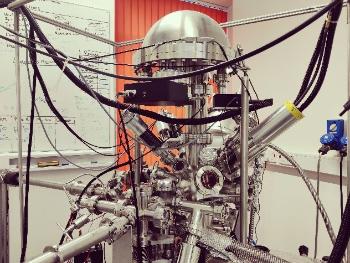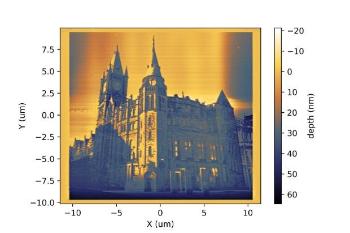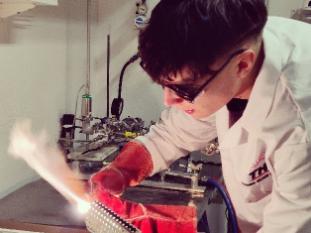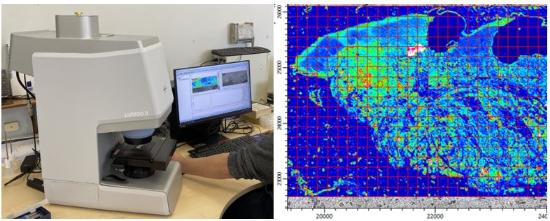Facilities
Condensed matter physics facilities
Advanced characterisation
Our characterisation capabilities embrace both local equipment, University Shared Facilities and international synchrotron facilities managed from Liverpool.
Surface physics facilities: X-ray photoelectron spectroscopy (monochromatic x-ray source); inverse photoemission; ultraviolet photoelectron spectroscopy; low energy electron diffraction including LEED I-V; scanning tunnelling microscopy and atomic force microscopy; atomic force microscopy (AFM); reflection anisotropy spectroscopy (RAS).
Personnel: Emeritus Prof Vin Dhanak, Dr David Martin, Dr Hem Raj Sharma
-247x252.jpg)
STM image of Pb atoms on an Ag-In-Yb quasicrystal surface
Spectrally resolved optical scattering - dark-field microscopy (custom-built around Zeiss microscope and Princeton Instrument spectrometer/LN2-cooled CCD camera)Personnel: Dr Frank Jaeckel
Rigaku SmartLab XRD: a multifunctional XRD platform for powder diffraction; x-ray reflectivity; texture and pole figures; reciprocal space mapping; in-plane diffraction; grazing incidence XRD and high throughput screening.
Further information
Contact: xrd@liverpool.ac.uk


Rigaku Smart Lab XRD (top), Monochromated XPS (bottom)
Laue back reflection camera: with motorised goniometer and fast data acquisition time (Photonic Science).
Contact: ken.durose@liverpool.ac.uk
Magnetic materials characterisation:
‘DMO NanoMOKE3’, Magneto-optical Kerr Effect microscope for thin film MOKE microscopy and domain imaging. Polar, transverse and longitudinal geometry, up to 8 kOe field range.
Low temperature magnetotransport, sub-2 K base temperature, up to 5 kOe maximum field. 20 electrical contact, chip carrier interface.
Magnetic particle imaging systems for sub mg/ml detection of superparamagnetic nanoparticle detection.
Cryogen-free measurement system, 1.6 to 400 K temperature range, 5 T field, sample in exchange gas. Magnetometer and AC susceptibility, down to \mu emu detection. Electrical properties measurement setup, 6 pin, 2x orthogonal sample platform.
XMaS Beamline at Grenoble:
XMaS is an EPSRC funded National Research Facility supporting the UK X-ray Materials Science communities. It is managed by the Universities of Liverpool and Warwick and provides free at the point of access to synchrotron radiation at the European Synchrotron Radiation Facility (ESRF) in Grenoble (France). A wide range of sample environments allow a diverse set of experiments to be performed using energies in the 2.1 to 40 keV range.
Techniques available include: diffraction; resonant x-ray scattering, grazing incidence measurements, spectroscopy and small angle scattering.
There are two calls for beam time proposals per annum, more information may be found at: Warwick.ac.uk XMaS website
Personnel: Dr Laurence Bouchenoire (Research Staff, Grenoble), Dr Yvonne Grunder, Prof Chris Lucas, Dr Hem Raj Sharma, Mr Paul Thompson (Research Staff, Grenoble), Dr Didier Wermeille (Research Staff, Grenoble)
Advanced materials laboratories
Nanolithography suite:
‘Nanofrazor’ thermal scanning probe lithography system, capable of 20 nm patterning of thin films.
Spin coater, plasma asher, reactive ion etcher, physical vapour deposition system, combined ball and wedge wirebonder (F&S Bondtec 53xxBDA), Heidelberg instruments laser lithography system, ELPHY Quantum electron beam lithography tool.

Magnetic materials lab:
Ultra-high vacuum electron beam deposition chamber for magnetic and non-magnetic materials, metals and insulators. Base pressure 10^-10 Torr, 10 source e-beam evaporator, 70 cm throw distance, capable of two-source co-deposition. Heater stage, up to 1000 C temperature range. Glancing angle deposition option, with two rotation axes.
Solar energy materials lab:
DC and RF sputtering; close space sublimation; spin coating; metallisation; direct synthesis of chalcogenides from the elements; Bridgman growth.
Personnel: Dr Jon Alaria, Prof Ken Durose, Dr Liam O’Brien, Dr Jon Major
Chemical and electrochemical physics laboratories
Laser cooling and ion trapping for chemical reaction dynamics studies.
Personnel: Prof Brianna Heazlewood
Electrochemical interfaces: Cyclic voltammetry.
Personnel: Dr Yvonne Grunder, Prof Chris Lucas
Imaging and medical diagnostics laboratories
The group have facilities for the preparation, imaging and analysis of biological specimens and in particular cancer biopsies. They have two key instruments for obtaining infrared (IR) spectral images of specimens.
LUMOS II The LUMOS II is a cutting-edge Fourier Transform Infrared (FTIR) spectral imaging instrument. It can collect over a million spectra every hour, covering the biologically significant mid-infrared region (4000-750 cm-1) of the electromagnetic spectrum, with an imaging spatial resolution of 5µm.
IR Aperture Scanning Near-field Optical Microscope (SNOM)
The SNOM instrument, developed within the Department of Physics, provides complementary capabilities to the LUMOS II by overcoming the diffraction limit imposed on far-field techniques. This enables the acquisition of IR images with sub-micron spatial resolutions, providing specialised insights which are otherwise impossible to obtain. This is accomplished by integrating the SNOM with a MIRcat quantum cascade laser (1965-1145 cm-1) and the production of custom SNOM fibres which are etched and gold coated in house. 
Personnel: Dr Steve Barrett (Hon Research Fellow), Dr Paul Harrison (Research Staff), Dr David Martin, Dr Paul Unsworth (Research Staff), Prof Peter Weightman
Solar energy conversion laboratory
We have a full laboratory for the preparation of new materials, investigation of their properties, incorporation into device and device testing for both solar hydrogen and electricity production. These include:
- Materials preparation: solid state synthesis; RF and DC sputtering (AJA International); close space sublimation (Electro-Gas Systems and Moorfield); thermal evaporation (Moorfield); spin coating; metallisation and contacting; nanoparticle synthesis
- Materials testing: UV-Vis-IR spectrophotometer (Shimadzu UV 3600); FTIR (Bruker Vertex 70V); surface profiler (Ambios 200); van der Pauw (CMT); Hall effect 0.8T, 7-300K (Semimetrics); temperature dependent conductivity (30-400K); high temperature DSC/TGA (Thermal Analysis).
- Device testing: AM1.5 solar simulator (TS Space Systems); external quantum efficiency (Bentham) deep level transient spectroscopy (Phystech FT1230); temperature dependent J-V (30 – 400K); Gas chromatography for hydrogen generation (Bruker)

Quartz tube sealing for solid state synthesis

High temperature TGA/DSC
Personnel: Prof Ken Durose, Dr Frank Jaeckel, Dr Jon Major, Dr Laurie Phillips (Research Staff), Prof Tim Veal
University of Liverpool Shared Facilities
The CMP team enjoys use of the University’s extensive shared facilities which include SEM, TEM, LEIS, XRD. Micro x-ray CRT, Ultrafast Transient Absorption Spectroscopy and NanoFrazor nanofabrication. For further information see the Research facilities and equipment webpage.

